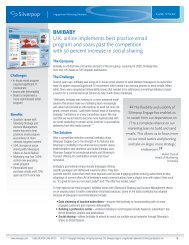eBook - Silverpop
eBook - Silverpop
eBook - Silverpop
Create successful ePaper yourself
Turn your PDF publications into a flip-book with our unique Google optimized e-Paper software.
the price in your email, consider sending the<br />
correction email only to the people who clicked<br />
on the affected product link.<br />
Create a trigger-based correction email that is<br />
sent only to recipients who click on the specific<br />
product link.<br />
8. Apologize in other channels. If the error is<br />
significant enough, you’ll probably want to use<br />
your other channels to apologize, post the correction<br />
or provide updates. These include your<br />
Web site, social media and blog.<br />
9. Use a personal tone that matches your<br />
recipients’ expectations. Your apology should<br />
reflect your company or corporate personality.<br />
Be humble, especially if the mistake could<br />
jeopardize your subscribers’ faith and trust in<br />
your brand.<br />
Use humor if the mistake lends itself to it. But<br />
be sure your humor is directed at yourself and<br />
doesn’t sound as if you’re taking customers’<br />
concerns lightly.<br />
10. Find a way to turn the error into an opportunity.<br />
The combination of an original<br />
error-laden email followed by a well-executed<br />
correction/apology email might increase your<br />
total revenue, conversions or other goals.<br />
While deliberately sending erroneous emails<br />
is not a good long-term strategy, design your<br />
correction email to support the original email’s<br />
goal. Margins aside, an additional incentive<br />
in the correction email can drive incremental<br />
conversions.<br />
11. Proof the correction email. Pull in people outside<br />
your team to review your message for typos<br />
and bad links and to be sure the tone and content<br />
convey your desired impact. Sending a correction<br />
email with another error is clearly something to<br />
avoid. Also, send a “proof” email first and include<br />
the other departments that might be affected on<br />
the distribution.<br />
12. Measure the impact. Measure both process<br />
metrics (e.g., opens, clicks, unsubscribes and spam<br />
complaints) and output metrics (conversions,<br />
downloads, registrations, etc.) on your mistake<br />
and corrected/apology emails.<br />
Analyze whether your approach and any incentives<br />
generated positive results. Also, understand<br />
how the two emails affected unsubscribe and<br />
spam complaint rates. A markedly higher-thannormal<br />
rate means that your response did not line<br />
up with expectations.<br />
13. Learn from the mistake. Once the dust<br />
settles, determine how it happened. Was it a<br />
simple user error from lack of training on your<br />
email platform? A poor review/proofing process?<br />
Did someone circumvent your standard process?<br />
If needed, revise your creative and production<br />
processes to minimize future mistakes.<br />
SILVERPOP.COM | PAGE 124







